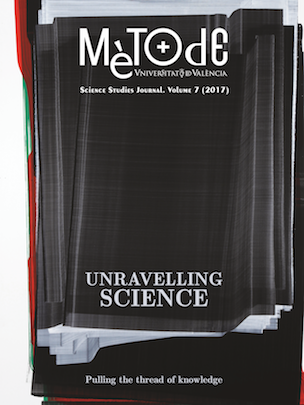A mysterious Universe: Revealing the bright and dark sides of the cosmos
DOI:
https://doi.org/10.7203/metode.7.8793Paraules clau:
cosmology, astrophysics, baryons, dark matter, dark energy Resum
Resum
Why is our universe as we observe it? Will it be the same forever? Understanding the nature of the main constituents of the universe is crucial to obtain a precise description of the way in which it reached its present state. Nowadays, many independent observations support a picture in which the matter content of the universe is shared between an ordinary and observable baryonic component (~5?%) and an invisible dark matter (~23?%). The remaining ~72?% of the universe content is in the form of a completely mysterious dark energy field. This composition emphasizes that, while ~95?% of our universe represents a major uncertainty for us, even the minor contribution from normal and, apparently, known matter entails important challenges for cosmologists.
 Descàrregues
Descàrregues
 Referències
Referències
Bull, P., Akrami, Y., Adamek, J., Baker, T., Bellini, E., Beltrán Jiménez, J., ... Winther, H. A. (2016). Beyond LCDM: Problems, solutions, and the road ahead. Physics of the Dark Universe, 12, 56–99. doi: 10.1016/j.dark.2016.02.001
Eckert, D., Jauzac, M., Shan, H., Kneib, J. P., Erben, T., Israel, H., ... Tchernin, C. (2015). Warm-hot baryons comprise 5-10 per cent of filaments in the cosmic web. Nature, 528, 105–107. doi: 10.1038/nature16058
Hamilton, J. Ch. (2013). What have we learned from observational cosmology? Studies in History and Philosophy of Science Part B: Studies in History and Philosophy of Modern Physics, 46(A), 70–85. doi: 10.1016/j.shpsb.2013.02.002
Hernández-Monteagudo, C., Ma, Y.-Z., Kitaura, F. S., Wang, W., Génova-Santos, R., Macías-Pérez, J., & Herranz, D. (2015). Evidence of the missing baryons from the kinematic Sunyaev-Zeldovich effect in Planck data. Physical Review Letters, 115(19). doi: 10.1103/PhysRevLett.115.191301
Moskowitz, C. (2016, April 11). Cosmic speed measurement suggests dark energy mystery. Scientific American. Retrieved from http://www.scientificamerican.com/article/cosmic-speed-measurement-suggests-dark-energy-mystery/
Olmo, G. J. (2012). Open questions in cosmology. Rijeka: InTech. doi: 10.5772/45746
Riess, A. G., Macri, L. M., Hoffmann, S. L., Scolnic, D., Casertano, S., Filippenko, A. V., ... Foley, R. J. (2016). A 2.4 % determination of the local value of the Hubble constant. The Astrophysical Journal, 826(1). doi: 10.3847/0004-637X/826/1/56
Descàrregues
Publicades
Com citar
-
Resum1058
-
PDF 497
Número
Secció
Llicència
![]()
Tots els documents inclosos en OJS són d'accés lliure i propietat dels seus autors.
Els autors que publiquen en aquesta revista estan d'acord amb els següents termes:
- Els autors conserven els drets d'autor i garanteixen a la revista el dret a la primera publicació del treball, llicenciat baix una llicència de Reconeixement-NoComercial-SenseObraDerivada 4.0 Internacional de Creative Commons, que permet a altres compartir el treball amb un reconeixement de l'autoria del treball i citant la publicació inicial en aquesta revista.
- Es permet i s'anima els autors a difondre la versió definitiva dels seus treballs electrònicament a través de pàgines personals i institucionals (repositoris institucionals, pàgines web personals o perfils a xarxes professionals o acadèmiques) una vegada publicat el treball.





